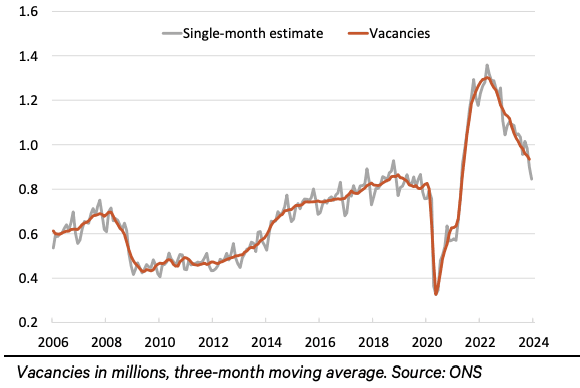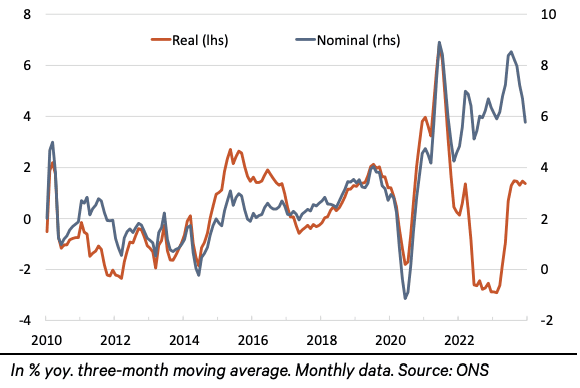Wage Surprise Boosts Pound Sterling Against Euro and Dollar
- Written by: Gary Howes
-

Image © Adobe Images
Pound Sterling hit a 25-week high against the Euro and rose against all its G10 peers after UK wage data beat expectations and the UK unemployment rate fell again, confirming the labour market is strong enough to ensure inflation stays elevated.
The Pound to Euro exchange rate rose to from 1.1755 in the hours after after the ONS said average earnings, with bonuses included, fell to 5.8% from 6.7% year-on-year in the three months to December. But this exceeded an expectation for a greater fall to 5.6%, stirring the market into action.
When bonuses are excluded, the rate stands at 6.2%, down from 6.7% but above the expected 6.0%.
The Pound to Dollar exchange rate rose to 1.2670 from 1.26 ahead of the release, confirming the market sees these figures as being consistent with UK interest rates staying at current levels for longer.
Odds of a June rate cut at the Bank of England faded slightly following the wage data, as they confirm the Bank of England's suspicion that inflation will prove difficult to return to the 2.0% target as a result of strong wage dynamics.
Wages will prove slow to fall back and ease inflationary pressures owing to the strong labour market, where the unemployment rate is reported at 3.8% by the ONS, which is below the 4.0% the market was expecting.
"It's unlikely we will see a sudden spike in unemployment anytime soon as we are still seeing a strong demand for staff," says a post-release comment from The Hoxton Mix, a virtual address and office provider.
Above: GBP/USD (top) and GBP/EUR showed a clear reaction immediately after the labour survey release. Track GBP with your own custom rate alerts. Set Up Here
The Bank said at its February policy update it sees inflation dipping to the 2.0% target by April but edging higher again over the remainder of the year and ending 2024 closer to 3.0%. It said it would hold Bank Rate at 5.35% for an extended period and that market expectations for an early rate cut were off the mark.
Three-month-on-three-month growth in the Labour Force Survey measure of employment slowed to 72K in December, from 108K in November, but topped the consensus, 50K.
Payroll employee numbers are provisionally estimated to have risen by 48K month-to-month in January, above the consensus, -18K.
Job vacancies continued a steady fall, standing at 932K in the three months to January, down 26K from the three months to October. Although down 209K on a year-to-year basis, vacancies are nevertheless still above pre-Covid levels.
Track GBP with your own custom rate alerts. Set Up Here
Kallum Pickering, an economist at Berenberg Bank, says the UK unemployment rate has only been lower in two brief periods, in 1973 and in 2022.
"After a solid 108k 3m/3m rise in employment in November, the labour market added another 72k jobs in December. At 75%, the employment rate for prime-age workers (16-64) remained well above the 71.5% average going back to 1971, but slightly below the all-time peak of 76.2% in January 2020," says Pickering.
He also offers a useful explainer as to why the labour market continues to hold up, defying various predictions for a significant deterioration.
Image courtesy of Berenberg Bank.
"The UK labour market remains in great shape. This is down to two factors," he explains:
First, businesses prefer to retain their workforces and wait for conditions to improve – instead of shedding workers in response to temporary economic weakness, only to struggle to rehire workers with sufficient skills once the recovery takes hold.
Second, after initially reacting too late to inflationary pressures in 2021, the Bank of England (BoE) has not gone overboard with rate hikes. Credit conditions have tightened enough to slow demand and lower inflation expectations, thereby reducing nominal wage pressures, but not to such an extent as to crash the economy and trigger a plunge in labour demand.
Above: Real wages are up as UK inflation recedes, nominal wages are falling.
And what does this mean for the Bank of England?
Markets have pushed back expectations for the timing of the first rate cut, and for the number of cuts to fall in 2024 as a whole.
Economists we follow are now rounding on a June or August date for the first move.
Pickering says he likes June as "the BoE will need to start to take its foot off the brake soon".
"Even though money market rates have fallen in anticipation of forthcoming rate cuts, past rate hikes are still feeding through the housing market and to businesses that are rolling over debt. To keep the labour market on track and to underpin a broader recovery in economic activity in 2024, the BoE will need to start to take its foot off the brake soon," he explains.
Berenberg looks for the first 25bp cut in June and five cuts overall in 2024, lowering the bank rate from 5.25% to 4% by year-end.








